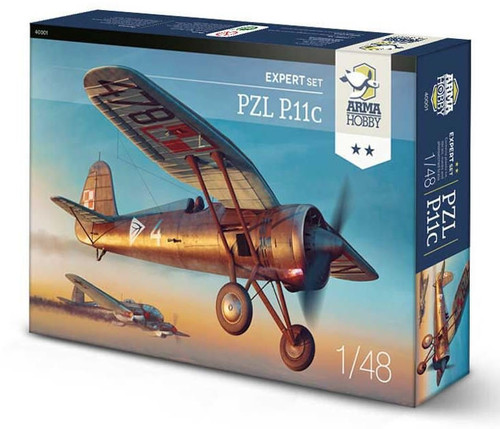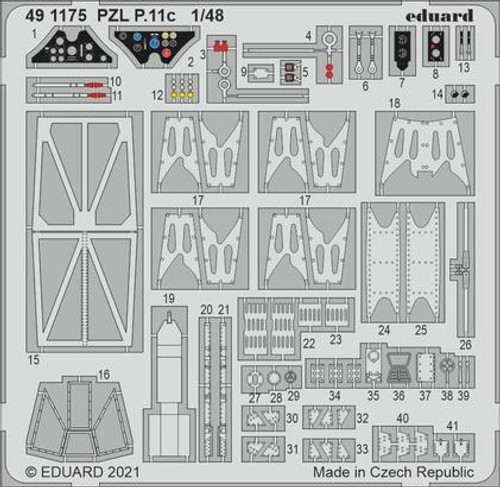Description
Set contains
- plastic parts - new tool, metal moulds
- Techmod decals with four marking options 1938-1939
- small photoetched fret with the most important minute details
Colours and markings of the PZL P.11c Model Kit
- PZL P.11c, 161 Fighter Squadron from Lvov, Spring 1939, pilot Ltn. Jan Dzwonek. Aeroplane with unofficial new squadron emblem design (turkey) painted on starboard fuselage side. The emblem was painted by the pilot during duty in the Border Protection Corps (K.O.P.) outpost in Sarny (Volhynia) during Spring 1939.
- PZL P.11c, 161 Fighter Squadron from Lvov, August-Septmeber 1939, pilot Ltn. Jan Dzwonek. After return from the outpost K.O.P. insignia an stripes on the wing were overpainted with fresh paint. The aeroplane took part in series of aerial combats on 2nd September 1939 South of Łódź. Pilot claimed ½ Hs 126. Then he was shot down by Bf 110 and badly wounded.
- PZL P.11c, 161 Fighter Squadron from Lvov,
- Lubitów Airfield near Kowel, Volhynia Field Exercises, August 1938.
- PZL P.11c, 152 Fighter Squadron from Wilno, September 1939. Aeroplane piloted by Cpl. Antoni Joda was damaged by Flak during reconnaissance mission and destroyed during forced landing at Zegrze on 10 September 1939.
PZL P.11c - "Kresy" squadrons
Legendary PZL P.11c is known as a defender of Poland in September 1939. It has been created three years after the death of Zygmunt Puławski, designer of the gull-winged PZL fighters family. The „c” version has been designed by Wsiewołod Jakimiuk as a development of the first production version, the PZL P.11a. Modifications included fuselage front (truss construction instead of stressed-skin), raising of the pilot's seat and lowering the engine, which improved visibility from the cockpit. Power unit was stronger, 600 hp variant of the British Bristol Mercury version, license produced in Warsaw. Armament was strengthened with two additional machine guns in wings and racks for four bombs. Jakimiuk introduced also completely new rounded fin shape and longer streamlined fairing behind pilot's head.
First P.11c from the ordered batch of 150 airframes reached the units in 1935. Air force re-armament process was never fully finished due to creation of the new squadrons. As a result, almost all the fighter wings went to the war with PZL P.11 in both „a” and „c” versions and three squadrons had to use obsolete PZL P.7a.
P.11c in "Kresy" Squadrons
Last units equipped with P.11c were the new squadrons: 152. EM from the 5th Aviation Regiment (Wilno) and 161. EM from the 6th Aviation Regiment (Lwów). They were formed to defend Polish Eastern Borderlands (Kresy) from active Soviet infiltration. In summer 1938 there were big exercises held in Volhynia to prepare against possible Red Army attack. The squadrons also sent temporary detachments to Border Protection Corps (K.O.P.) outpost in Sarny in Volhynia. In 1939 Campaign 152. EM was attached to the Army Modlin and 161. EM (and 162. EM with P.7a) to the Army Łodź.
In 1939 the „elevens” fought the Germans since 1st September morning till the evacuation forced by the Soviet aggression on 17th September. Despite being already quite obsolete and inferior in speed and armament even to the German bombers, thanks to extraordinary maneuverability and pilot's skills P.11 fighters managed to effectively oppose the enemy, sometimes even to win in dogfights against fighters. While the losses have been high, 35 airworthy PZL P.11c were evacuated to Romania. These planes have been confiscated by Romanians and joined their PZL P.11band f and P.24 fleet. Since 22nd June of 1941 the „elevens” marked with yellow crosses took part in the war against Soviet Union, remaining in frontline units till the September 1943!
















